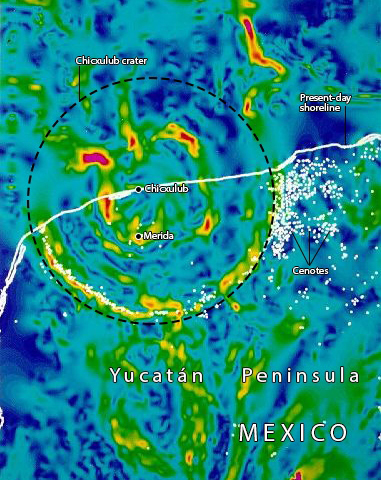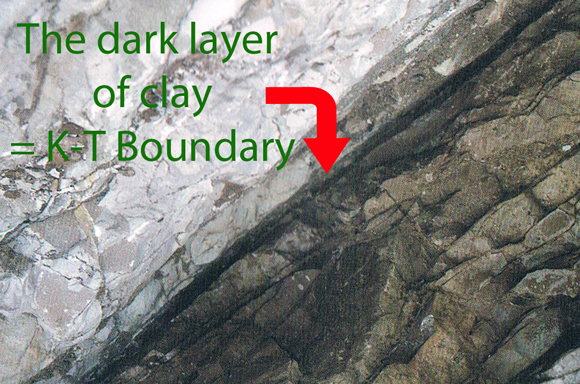Concentrated Levels of Iridium Found at Chicxulub Impact Site
High levels of the rare Earth element iridium have been found in drill cores taken from the peak-ring sequence of the Chicxulub impact site located on the Yucatan peninsula (Mexico). This evidence further supports the theory that the extra-terrestrial space object that smashed into our planet some 66 million years ago is linked to the Cretaceous-Palaeogene (K-Pg) mass extinction event.
Extra-terrestrial Object Hits Earth

Picture credit: Map from Nature Geoscience / illustration courtesy of NASA
In 2016, IODP-ICDP* Expedition 364 drilled into the Chicxulub crater’s peak ring, an irregular ring of hills that surrounds the crater’s centre bringing around 835 metres of rock to the surface for detailed laboratory analysis.
* IODP (International Ocean Discovery Program) and the ICDP (International Continental Scientific Drilling Program).
The Chicxulub Impact Site
Iridium is extremely rare on Earth, although a spike in levels has been recorded at numerous sites around the world that represent deposits laid down around 66 million years ago. The researchers state that the iridium levels found in the drill cores are four times more concentrated than elsewhere. The scientists found iridium levels were highest across the transition into early Paleogene sediments (Danian faunal stage).
A Geophysical Map of the Chicxulub Impact Site

Picture credit: NASA
A Vapourised Bolide
Writing in the academic journal “Science Advances” the researchers conclude that this evidence combined with the spike in worldwide iridium deposits at the time of the mass extinction event, constitutes indisputable evidence that the suspected dinosaur-killing bolide that created the Chicxulub crater was indeed the culprit.
Commenting on the significance of this research, co-author Professor Joanna Morgan (Imperial College London) stated:
“This asteroid was vaporised and ejected from the impact site at high speed. Iridium, and other asteroidal material, then circled the Earth above the stratosphere within a fast-moving dust cloud and may have taken up to two decades to settle through the atmosphere and ocean before being deposited at the impact site.”
Lead author of the study, Professor Steven Goderis of the Free University of Brussels-VUB added:
“It’s quite remarkable that we found concentrations this high within the impact structure itself. In the first hours to months after the impact, the crater was a highly turbulent environment affected by tsunamis and earthquakes. Luckily, the iridium layer was preserved. This unquestionably ties the formation of the crater to the mass extinction event that marked the end of the Cretaceous and confirms that the asteroid impact and dinosaur extinction are indisputably linked.”
The Iridium Clay Layer Marks the Impact Event

Picture credit: The Open University/Everything Dinosaur
Everything Dinosaur acknowledges the contribution of a media release from Imperial College London in the compilation of this article.
To read a related article looking at how palaeontologists interpret fossil evidence of a global impact event: Quarry Site Might Reveal Evidence of Cretaceous Mass Extinction Event.
The scientific paper: “Globally distributed iridium layer preserved within the Chicxulub impact structure” by Steven Goderis, Honami Sato, Ludovic Ferrière, Birger Schmitz, David Burney, Pim Kaskes, Johan Vellekoop, Axel Wittmann, Toni Schulz, Stepan M. Chernonozhkin, Philippe Claeys, Sietze J. de Graaff, Thomas Déhais, Niels J. de Winter, Mikael Elfman, Jean-Guillaume Feignon, Akira Ishikawa, Christian Koeberl, Per Kristiansson, Clive R. Neal, Jeremy D. Owens, Martin Schmieder, Matthias Sinnesael, Frank Vanhaecke, Stijn J. M. Van Malderen, Timothy J. Bralower, Sean P. S. Gulick, David A. Kring, Christopher M. Lowery, Joanna V. Morgan, Jan Smit, Michael T. Whalen and the IODP-ICDP Expedition 364 Scientists published in Science Advances.
Visit the Everything Dinosaur website: Everything Dinosaur.

